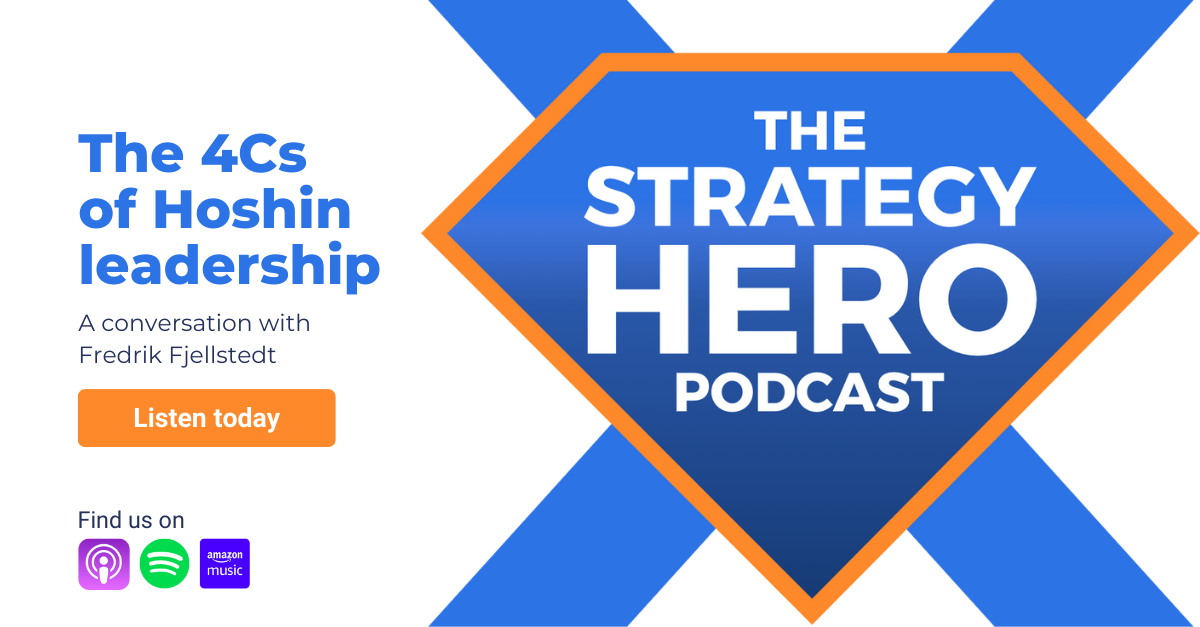The x-matrix is the visual centerpiece for organizations using Lean and Hoshin Kanri for their strategic planning - but is complexity keeping others away?
In strategic planning, the Hoshin Kanri methodology and its visual centerpiece, the x-matrix, stand out as powerful tools for aligning an organization with its strategic objectives.
Despite their potential, these tools often garner a reputation for complexity, causing some companies to hesitate to adopt them.
In this blog, we'll dissect the reasons behind this perceived complexity and shed light on how to navigate the intricacies of the x-matrix effectively.
1. Visual complexity: streamlining strategy
The x-matrix is a visually intensive representation that condenses numerous strategic elements into a single framework.
This convergence of the long-term vision, annual objectives, strategies, and key performance indicators (KPIs) within a single matrix can initially appear daunting.
This visual complexity may overwhelm individuals and teams unfamiliar with such a comprehensive strategic planning tool.
Tip: Visual clarity is key. The x-matrix, while intricate, offers a streamlined view of your strategy's interconnections.
2. Data-intensive: metrics as the backbone
Successful implementation of the x-matrix hinges on data and metrics.
Tracking progress and measuring performance through KPIs is essential.
However, organizations grappling with data management challenges or limited access to relevant data may perceive the x-matrix process as overly intricate and data-intensive.
Tip: Mastering data management simplifies the x-matrix. Invest in robust data strategies to make the process smoother.
3. Cross-functional collaboration: harmonizing efforts
Hoshin Kanri strongly emphasizes cross-functional collaboration, requiring active participation from various departments and teams.
Achieving alignment across these diverse groups can be formidable, especially in organizations marked by siloed structures or a need for established communication and collaboration practices.
Tip: Collaboration is the heart of Hoshin Kanri. Foster open communication and a culture of collaboration to make the x-matrix more accessible.
4. Cultural shift: transforming perspectives
Implementing Hoshin Kanri, including the x-matrix, often necessitates a profound cultural shift within an organization.
This shift may encompass changes in decision-making processes, goal-setting methodologies, and performance evaluation paradigms.
Resistance to such transformative cultural changes can amplify the perception that the methodology is excessively complex.
Tip: Cultural shifts require guidance. Leadership plays a pivotal role in navigating and simplifying this transformation. Listen to our podcast below to learn how you can adapt.
5. Training and education: empowering proficiency
Proficient utilization of the x-matrix requires comprehensive training programs that cater to employees at all levels.
These programs equip individuals with the knowledge and skills to effectively leverage the x-matrix.
A well-informed workforce is more likely to embrace the methodology with confidence.
Tip: Knowledge is power. Invest in education to empower your teams and reduce complexity.
6. Change management: navigating transformation
Effectively implementing Hoshin Kanri, including the x-matrix, often entails robust change management strategies.
Companies might view this as an additional layer of complexity, particularly if they need more experience in managing organizational change.
Tip: Change management is about guiding, not complicating. Employ seasoned change management experts to smooth the transition.
7. Initial overhead: the investment of resources
Launching the x-matrix and integrating Hoshin Kanri into an organization's strategic planning processes can impose significant initial overhead in time, effort, and resources.
This initial investment may appear daunting and complex to organizations contemplating its adoption.
Tip: Consider it an investment, not a cost. The x-matrix can yield significant returns when executed effectively.
8. Lack of expertise: the need for guidance
Access to experts or consultants with extensive experience in Hoshin Kanri is not always readily available.
The absence of such expertise can pose a considerable challenge, making it difficult for organizations to navigate and implement the methodology effectively.
Tip: Seek external guidance when needed. Experienced consultants can provide invaluable insights and guidance.
9. Historical complexities: learning from past experiences
In some instances, companies may have made previous attempts at implementing Hoshin Kanri or similar methodologies, only to encounter disappointing outcomes.
Negative historical experiences can contribute to a perception that the x-matrix is inherently complex and fraught with challenges.
Tip: Reflect and refine. Learn from past experiences to streamline and simplify future implementations.
10. Overemphasis on tools: embracing the philosophy
Companies occasionally emphasize the tool itself—the x-matrix—rather than embracing the underlying principles and philosophies of Hoshin Kanri.
This tool-centric approach can obscure the simplicity inherent in the methodology, causing it to appear more intricate than it truly is.
Tip: It's not just a tool; it's a philosophy. Focus on the "why" behind the x-matrix to simplify its implementation.
Is the complexity real?
Yes. The perceived complexity of the x-matrix and Hoshin Kanri is a challenge, but one that organizations can overcome through strategic planning, investment in education, and a commitment to cultural transformation.
By recognizing that the true power of the x-matrix lies in its ability to align an organization with its strategic goals, companies can navigate its intricacies effectively and reap the benefits of streamlined and empowered strategic planning.
Continue learning about Hoshin Kanri
Click here for further information on Hoshin Kanri, or continue your journey with these recommendations:
- The Hoshin Kanri x-matrix: what, how, why, benefits, and more: Discover how the x-matrix works and how you can make your own in our free Excel template
- Danaher, Ingersoll Rand, and Xerox: Hoshin Kanri in practice: Learn why the experiences of these companies can teach us a lot about adopting Policy Deployment / Hoshin Kanri.
- Download our Hoshin Kanri eBook: Read how Hoshin Kanri supports organizations to drive great business results, how two businesses have used the methodology to build their business systems, case studies, and more.
About the author
James Milsom is Head of Marketing at i-nexus. As Head of Marketing, his drive is to raise awareness and understanding of the challenges facing enterprises in delivering strategic objectives and transformation amidst changing markets and the obstacles traditional tools and methods present leaders.
If you’d like to talk more about strategy, reach out to James on james.milsom@i-nexus.com or connect with him on LinkedIn for the latest insights.



